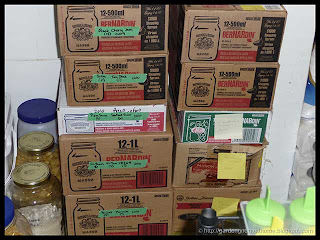When we moved here in 2007 we expected critter problems so they came as no surprise. The house is in a rural location on waterfront property which exposes us to a few more critters than if we were living in a urban setting. It did not help that much of the property was over grown providing the perfect habitat for many critters and while we have done a lot of ripping out there are still plenty of hiding spots for critters. We have dealt with centipedes, millipedes, pill bugs, earwigs, spiders, black ants, yellow jackets, wasps, mice, voles, skunks, rabbits and racoons. Critters tend to controlled by natural predators so unless a critter becomes a problem indoors or presents the risk of physical harm to humans my philosophy is to leave them be.

Spiders by an large are beneficial critters that should allowed to remain in your gardens providing there is a low risk of being bit and the spider is not toxic. Indoors spiders are wonderful indicators of drafts that should be sealed because they spin their webs where their egg sacks can be kept cool. Outdoors spiders keep insects in check. In most cases manual removal of the spider and any egg sacs is enough to solve any spider over population problems when combined with sealing them out of the house. Regular web removal outdoors will help control them as well.
I've been using the
spider identification chart to help identify some of the harmful spiders here. Pictured is a
golden orb-weaving spider that while large (about the size of a quarter) is non-agressive and non-toxic to humans. I have identified several problem spiders around our house with the worst ones being the
brown recluse spider and
house spider both aggressive and toxic spiders.
I blogged about the
funnel spiders on my gardening blog. While these are non-aggressive, low risk of a bit spiders this year they are presenting a problem just in their shear numbers. These spiders are toxic which could be very problematic with three little grandchildren running around. All of the cedar hedges and English boxwoods are covered with these spiders. I've only seen a couple indoors though so that is a good thing.
Manual removal of these fast moving spiders is impossible although sweeping down the hedges helps somewhat. Given their numbers I am going to spray the hedges to do a good but not total knockdown. A total knockdown of spiders outdoors is virtually impossible and not desirable anyway. All I'm looking for is a reasonable knockdown that will lessen the chances of any spider bite problems.
Insecticides are something I prefer not to use if at all possible. Insecticides when used indiscriminately knock out all insects and arachnids including the beneficial ones like pollinators and the golden orb-weaving spider. I garden organically so don't want any overspray getting onto my vegetables or into the soil. I also don't want insecticides making their way into the natural body of water where they can do a lot of damage.
I'm using two specific application insecticides. The first is Bio-Mist by Green Earth. This product is safe for use on vegetation and can be used to do a
rapid knockdown aroung the perimeter of the house if necessary. It kills on contact without a residual effect. I will be using this on the cedars and boxwoods to lower the funnel spider population. SpiderBan® by Wilson® is a targetted indoor/outdoor spider killer that kills on contact as well as a residual effect. This product has a low mammalian toxicity but is highly toxic to fish and bees. It will kill spiders on the house and has enough of a residual effect to continue killing any spiders that come into contact with the surfaces sprayed with this insecticide will continue to be killed. This insecticide is specifically useful for treating outdoor surfaces like siding and brick as well as indoor cracks and crevices. While most residual insecticides will give the residual time frame Wilson® does not but from experience this product will give a good 6 month effect. I will be using SpiderBan® to treat only the house and garage directly on the buildings.

When we moved here we called a pest control company for the spiders. They quoted us a price of $250 for outdoor spraying only. I decided to look for a way to do this ourselves. The ideal applicator is a pressurized pump sprayer. You mix the concentrate with water in the sprayer then put the lid on and pump the handle until it is very stiff then tighten it down. The contents can then be sprayed under pressure through the nozzle by pressing the red lever (middle of hose). At under $25 a pressurized pump sprayer is a low cost, low tech, mecanical way to apply pesticides. If you use natural pesticides (eg. vinegar), chemical herbicides (eg. Round-up), chemical insecticides (eg. SpiderBan) or natural insecticides (eg. soap solution) you will want 4 of these sprayers well marked with their intended uses so you don't make the mistake of spraying a chemical insecticide on your organic vegetable garden.
Garden Gnome
©2006-2010




























